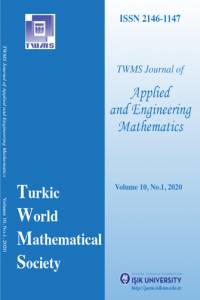QUANTUM SPECTRAL CLUSTERING THROUGH A BIASED PHASE ESTIMATION ALGORITHM
Spectral Clustering Quantum Algorithms.,
___
- Kempe, J., (2003), Quantum random walks: An introductory overview, Contemporary Physics, 44(4), pp. 307–327.
- Faccin, M., Migda l, P., Johnson, T. H., Bergholm, V. and Biamonte, J. D., (2014), Com- munity detection in quantum complex networks, Physical Review X, 4(4), p. 041012.
- Wiebe, N., Kapoor, A. and Svore, K. M., (2015), Quantum algorithms for nearest- neighbor methods for supervised and unsupervised learning, Quantum Information & Computation, 15(3-4), pp. 316–356.
- Wiebe, N., Kapoor, A. and Svore, K. M., (2016), Quantum deep learning, Quantum
- Information & Computation, 16(7-8), pp. 541–587. A¨ımeur, E., Brassard, G. and Gambs, S., (2013), Quantum speed-up for unsupervised learning, Machine Learning, 90(2), pp. 261–287.
- Lloyd, S., Garnerone, S. and Zanardi, P., (2016), Quantum algorithms for topological and geometric analysis of data, Nature communications, 7.
- Lloyd, S., Mohseni, M. and Rebentrost, P., (2014), Quantum principal component analysis, Nature Physics, 10(9), pp. 631–633.
- Biamonte, J., Wittek, P., Pancotti, N., Rebentrost, P., Wiebe, N. and Lloyd, S., (2017)
- Quantum machine learning, Nature, 549(7671), p. 195.
- Arunachalam, S. and de Wolf, R., (2017), A survey of quantum learning theory, arXiv preprint arXiv:1701.06806.
- Schuld, M., Sinayskiy, I. and Petruccione, F., (2015), An introduction to quantum machine learning, Contemporary Physics, 56(2), pp. 172–185.
- Kaufman, L. and Rousseeuw, P. J., (2009), Finding groups in data: an introduction to cluster analysis, volume 344, John Wiley & Sons.
- Daskin, A., (2016), Obtaining a linear combination of the principal components of a matrix on quantum computers, Quantum Information Processing, 15(10), pp. 4013–
- Daskin, A., (2018), A quantum implementation model for artificial neural networks, Quanta, 7, pp. 7–18.
- MacQueen, J. et al., (1967), Some methods for classification and analysis of multivariate observations, in Proceedings of the fifth Berkeley symposium on mathematical statistics and probability, volume 1, Oakland, CA, USA., pp. 281–297.
- Dhillon, I. S., Guan, Y. and Kulis, B., (2004), A unified view of kernel k-means, spec- tral clustering and graph cuts, Computer Science Department, University of Texas at Austin.
- Lloyd, S., (1982), Least squares quantization in pcm, IEEE transactions on information theory, 28(2), pp. 129–137.
- A¨ımeur, E., Brassard, G. and Gambs, S., (2007), Quantum clustering algorithms, in
- Proceedings of the 24th international conference on machine learning, ACM, pp. 1–8. Grover, L. K., (1996), A fast quantum mechanical algorithm for database search, in
- Proceedings of the twenty-eighth annual ACM symposium on Theory of computing, ACM, pp. 212–219. Von Luxburg, U., (2007), A tutorial on spectral clustering, Statistics and computing, (4), pp. 395–416.
- Shi, J. and Malik, J., (2000), Normalized cuts and image segmentation, IEEE Transac- tions on pattern analysis and machine intelligence, 22(8), pp. 888–905.
- Ng, A. Y., Jordan, M. I., Weiss, Y. et al., (2002), On spectral clustering: Analysis and an algorithm, Advances in neural information processing systems, 2, pp. 849–856.
- Zha, H., He, X., Ding, C., Gu, M. and Simon, H. D., (2001), Spectral relaxation for k-means clustering, in Advances in neural information processing systems, pp. 1057–
- Ding, C. and He, X., (2004), K-means clustering via principal component analysis, in
- Proceedings of the twenty-first international conference on Machine learning, ACM, p. 29. Jordan, F. and Bach, F., (2004), Learning spectral clustering, Adv. Neural Inf. Process. Syst, 16, pp. 305–312.
- Kitaev, A., (1996), Quantum measurements and the abelian stabilizer problem, Elec- tronic Colloquium on Computational Complexity (ECCC), 3(3).
- Nielsen, M. A. and Chuang, I. L., (2010), Quantum computation and quantum infor- mation, Cambridge university press.
- Mosca, M. et al., (1998), Quantum searching, counting and amplitude amplification by eigenvector analysis, in MFCS98 workshop on Randomized Algorithms, pp. 90–100.
- Brassard, G., Hoyer, P., Mosca, M. and Tapp, A., (2002), Quantum amplitude ampli- fication and estimation, Contemporary Mathematics, 305, pp. 53–74.
- Berry, D., Ahokas, G., Cleve, R. and Sanders, B., (2007), Efficient quantum algorithms for simulating sparse hamiltonians, Communications in Mathematical Physics, 270(2), pp. 359–371.
- Childs, A. M. and Kothari, R., (2011), Simulating sparse hamiltonians with star de- compositions, in Theory of Quantum Computation, Communication, and Cryptogra- phy, volume 6519 of Lecture Notes in Computer Science, Springer Berlin Heidelberg, pp. 94–103.
- Daskin, A. and Kais, S., (2018), Direct application of the phase estimation algorithm to find the eigenvalues of the hamiltonians, Chemical Physics, 514, pp. 87–94.
- Farhi, E., Goldstone, J. and Gutmann, S., (2014), A quantum approximate optimization algorithm, arXiv preprint arXiv:1411.4028.
- ISSN: 2146-1147
- Başlangıç: 2010
- Yayıncı: Turkic World Mathematical Society
K. DOGAN, F. GURSOY, V. KARAKAYA
K. R. AİDA-ZADE, V. M. ABDULLAYEV
H. SHAMSAN, R. S. A. QAHTAN, S. LATHA
